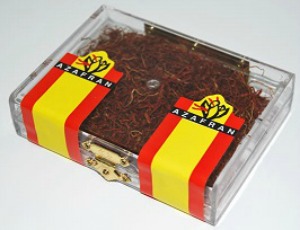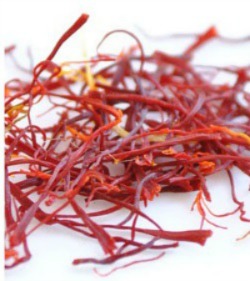Saffron is the stigma of the crocus flower, which originally came from Asia Minor. Saffron is called “zafran” in Spanish.
Today almost three-quarters of the world’s production of saffron is grown in Spain, specifically in the region of Castilla-La Mancha. Spanish saffron is prized for its high quality and commands twice the price of saffron produced in Iran.
Saffron has always being considered very valuable. In fact, at one point it was even used as currency. It forms part of the culinary culture of different regions in the world:
- In India saffron is an important ingredient in many recipes of rice, sweets, and ice-creams.
- In Saudi Arabia, a real Arabic coffee should have saffron and cardamom.
- In the North of Italy, saffron is essential in the preparation of its famous Risotto.
- In Sweden it is a traditional to bake saffron bread on the day of St. Lucile.
- In Spain saffron is an indispensable ingredient in such famous dishes as Paella.
Saffron, the yellow-orange stigmas from a small purple saffron crocus (Crocus sativus), commonly known as Rose of Saffron, is the world’s most expensive spice. That is because each flower provides only three (3) red stigmas. One (1) ounce of saffron = approximately 14,000 of these tiny saffron threads.
At a price of $2,000 to $10,000 a pound, saffron is considered the most expensive food on earth, way more than truffles, caviar, and real balsamic vinegar. Why is saffron so expensive – it is because of the labor needed to produce saffron – it is so labor intensive!
Each flower, which blooms for one week of the year, produces about three stamens, which must be picked by hand. The best saffron is harvested seasonally and carefully dried in the sun or over a low fire. Saffron is best when fresh and loses its potency over time. The tiny red threads of saffron must be handpicked from the center of the crocus flower. They leave behind the yellow stamens which have no taste. This spice comes either powdered or in threads (the whole stigmas). Less-expensive saffron powder is often made from poor quality saffron or old saffron.
History of Saffron:
Saffron is the stigma of the crocus flower, which originally came from Asia Minor before the birth of Christ, where it has been cultivated since ancient times:
Ancient Romans used to perfume their baths with saffron. Court ladies of Henry VIII’s reign tinted their hair with saffron until the monarch forbade it; he feared a saffron shortage that might reach his own table.
In the 1400, German dealers who were caught adulterating saffron were burned at the stake.
The Moors brought saffron or “az-zafaran,” as they called it, to Spain in the VIII or IX century during their invasion of Spain over a thousand years ago.
Arabs used saffron in medicine for its anesthetic properties. It was the Arabs who introduced the cultivation of saffron in Spain in the X century. Evidence of different kinds assure that saffron was an irreplaceable ingredient in the hispanic-arabic cooking of that age.
Shopping for Saffron:
Pure saffron is made up of tiny, bright-red threads. The redder the saffron, the higher the quality. The tips of the threads should be a slightly lighter orange-red color. This will show that it is not cheap saffron that has been tinted red to look expensive.
Spanish saffron is divided into grades. Names to look for are coupe, superior, La Mancha, or Rio. Coupe is the top of the line and it has the least flavorless yellow stem and the highest amount of crocin, one of the key essential oils in saffron.
Beware of bunk saffron. Saffron will always be expensive. If you see a packet of a couple ounces of saffron for just a few dollars, just put it back. Real saffron is VERY expensive and you only need a tiny bit when cooking. Do not fall for cheap saffron, as you will always get what you pay for!
Preparing Saffron for use in cooking:
Since heat releases saffron’s flavor essence, it needs to be steeped in hot water, broth, or even alcohol before being added to food. Pre-soaking also allows the color to disperse throughout the food.
Preferred Method – For every teaspoon of saffron, add 3 teaspoons of liquid; using a spoon make sure that the saffron threads get properly soaked (do not crush the threads). Let the saffron soak for a minimum of two hours. The mixture can be left soaking for as long as twelve hours, but two hours will give you the proper results. The leaves will expand to 1 1/2 times their dry size.
Quick Method – If you are in a hurry or have forgotten to soak the saffron, add 5 teaspoons of liquid for every teaspoon of saffron; let soak for 20 minutes. Using the back of a spoon or in your ceramic mortar, mash the threads so that a thick paste is formed. You can then add the paste to the dish when required.
Toasting Method – Carefully and slowly toast threads in a heavy skillet over low heat (watch carefully and do not allow to burn – burned saffron threads are irretrievable and unusable). T hen grind threads into a powder and use as directed in the recipe.
Cooking with Saffron:
The rule is that a “little saffron” will go a long way. When determining how much saffron to use in cooking, remember that the saffron flavor will be stronger the second day. In general, just use a pinch in soups and stews that serve 4 to 6 people.
Saffron is especially good when used in cooking seafood dishes such as bouillabaisse and paella. It is also used in risotto and other rice dishes. Try adding some to your next beef stew or tomato-based sauce. To make a wonderful marinade for fish, add saffron threads, garlic, and thyme to vinegar. Saffron is also used in bread and cake cooking. Use your imagination and be creative when using saffron in your cooking.
Saffron Cooking Tips:
If your recipe includes liquid (water, broth, or wine), use a little of it and pour over the saffron.
Turmeric may be substituted for the color properties, not not the flavor.
Do not use wooden utensils when mixing saffron. Wood utensils tend to absorb saffron easily. Since saffron is expensive, you don’t want to waste it.
Powdered Saffron:
Powdered saffron loses it flavor more rapidly and can easily be adulterated with less-expensive powders like turmeric. Buying cheaper saffron will no save money in the long run, since more will be needed for the same flavor impact. I personally do not recommend that you purchase powdered saffron.
Storing Saffron:
Saffron is very sensitive to light and moisture. tore it in a container away from sunlight. If stored properly, it will last for years.
Saffron absorbs other flavors and odors very easily. If you choose to transfer the saffron to a new container, make sure that the container is very clean and odor-free before using.
Comments From Readers:
I read with interest your writing on Saffron. There are however a number of inaccuracies in your article. The cost of the highest quality Saffron is around $1700 per Kilo for, far less than the Beluga Caviar.
160 Tons of the stuff which equates to 90% of the world’s Saffron is produced in the Khorasan Region of Iran and not Spain. In fact, Spanish Saffron that you have been using most likely came from Iran and was packaged in Spain. Currently this valuable spice is most economically produced in Iran and exported to other countries for use. Since the Spanish Saffron commands more prestige, traders purchase the Iranian produce and package under Spanish brands. For obvious reasons Spain and European Union have introduced measures to protect the Spanish Saffron from extinction.
Please note that the quality of the Iranian Saffron is greater than that of Spain due to favorable climate and advance drying processes they employ. With this mind, the best quality Saffron will not contain the yellow stems of the Stigmas. It will be pure Orangey Red in color with distinct Saffron odor.
Finally, while Paella is the only major Spanish Cuisine that contains Saffron, most Iranian dishes contain the spice in one way or another including the pastries, cakes, ice creams, and snacks. There is still a long way for the rest of the world to catch up with the intensive use of Saffron in their food preparations the way Iranians do.
Best wishes – Nasser Marand, London (11/4/14)



6 Responses to “Saffron – Crocus Sativus – Spanish Saffron”
Kesar
There is one more variety of Saffron, cultivated in Kashmir (India). The Kashmiri saffron is well known for its intense aroma and color
Aryan
1- Producing more than 95% (300 tons) of global consumption, Iran is the largest saffron exporter in the world, not Spain. With a huge difference, Spain and India are the second and third producers (less than 10 tons).
2- Persian saffron has the highest quality, smell and texture because of climate and soil composition.
3- Spanish saffron is in fact the re-packed and re-named Persian saffron.
Bezami
That’s true! You can easily google and find thousands of reliable resources to confirm that. Thanks for your comment.
Peace and Plenty Farm
Saffron is now being grown in Northern California! The mediterranean climate of California is perfect for saffron and we are producing, lovely, high quality saffron here.
Renee Marie Jacquemain
It is true that N. California climate and soil is exceptional for cultivating fine quality saffron. Move over East, the West is fast becoming a hub for fine culinary cuisine.
Sativus.com
You can grow saffron yourself quite easily if you buy high-quality Crocus sativus bulbs.